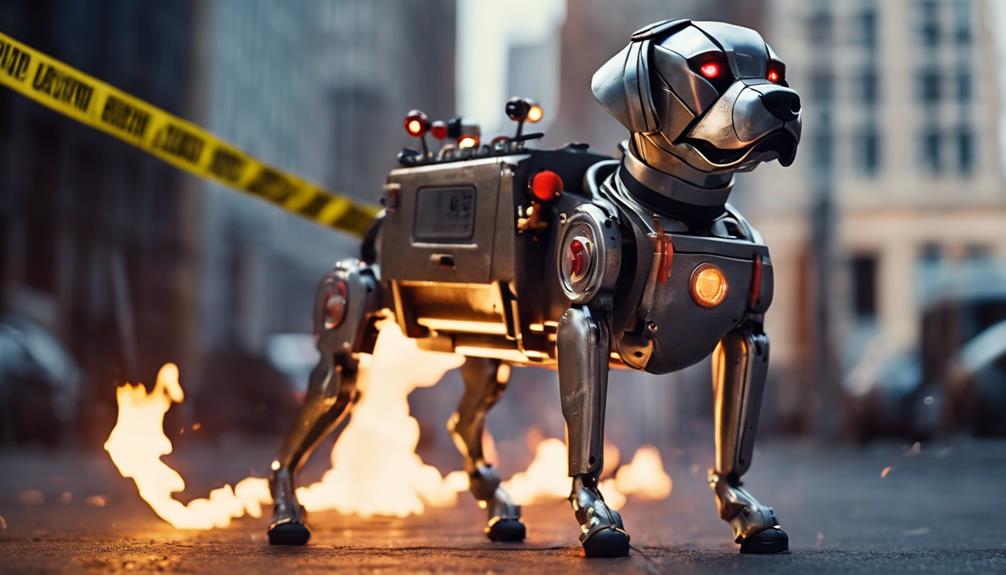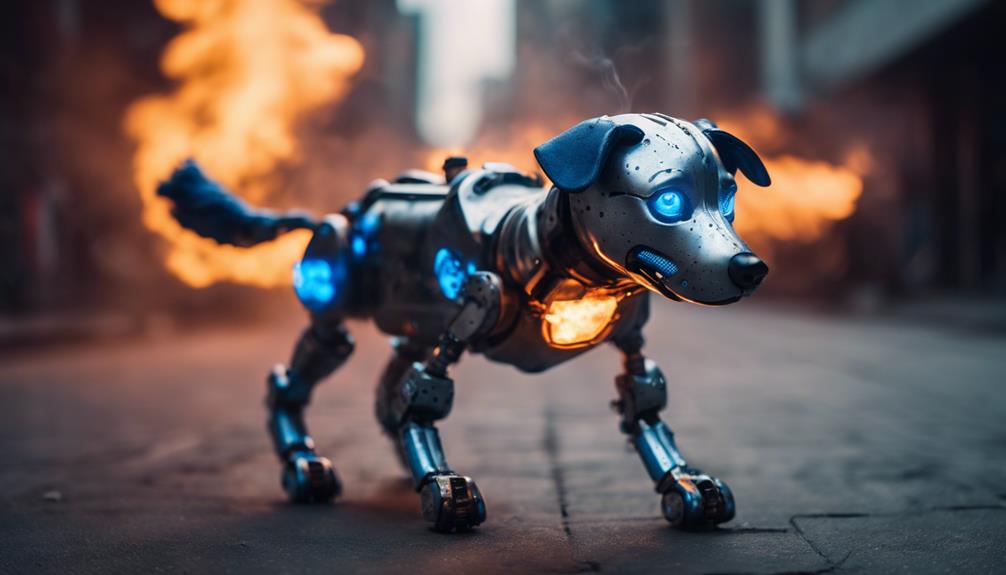The flamethrower robot dog represents a significant innovation in fire management technology. With a 30-foot flame projection range and a battery life of one hour, it effectively navigates hazardous environments using lidar technology. This automated device can assist in rapidly melting ice, managing wildfires through controlled burns, and enhancing agricultural practices. Priced around $9,420, it is legal in 48 states, though concerns over misuse and legal implications persist. As public sentiment recognizes its efficiency, ethical considerations continue to shape discussions about responsible use. To understand its broader implications and capabilities, further exploration is warranted.
Key Takeaways
- The flamethrower robot dog projects flames up to 30 feet, effectively melting ice and snow for improved safety.
- Operable via smartphone controls, the robot dog utilizes WiFi and Bluetooth for easy user interaction.
- Lidar technology enables precise navigation and mapping, enhancing operational effectiveness in various applications.
- It can assist in wildfire management through controlled burns, reducing risks to firefighters and agricultural workers.
Product Features

The Thermonator flamethrower robot dog boasts advanced features, including a 30-foot flame projection range and a one-hour battery life, all operable through smartphone controls via WiFi and Bluetooth connectivity.
This innovative device employs lidar technology to effectively navigate and map its surroundings, enhancing operational precision.
Designed with user-friendly controls, the Thermonator allows for seamless interaction and immediate responsiveness, making it accessible to a wide range of users.
Priced at approximately $9,420, it is legally available in 48 U.S. states, with the exception of Maryland.
The combination of cutting-edge technology and practical design positions the Thermonator as a notable advancement in robotic applications, pushing the boundaries of traditional functionalities in the domain of mechanized devices.
Applications and Benefits

Numerous applications for the Thermonator flamethrower robot dog highlight its versatility, particularly in ice and snow removal, wildfire control, and agricultural management. This innovative technology not only enhances efficiency but also addresses critical challenges in these fields.
- Rapid ice and snow melting, reducing hazards for pedestrians and vehicles.
- Proactive wildfire management, helping to create controlled burns that prevent larger disasters.
- Enhanced agricultural practices, facilitating weed control and crop management.
- Reduced human risk, minimizing the danger faced by firefighters and agricultural workers.
Legal Considerations

Legal implications surrounding the Thermonator flamethrower robot dog are complex, with ownership permitted in 48 states but restrictions in Maryland. Potential legal repercussions for misuse are significant, as past flamethrower sales have resulted in confiscations and fines for over 1,000 purchasers. Currently, there are no required security checks for buying the Thermonator, raising concerns about accountability. Additionally, state-specific penalties for misuse remain uncertain, which complicates the legal landscape for users.
| Aspect | Details | Considerations |
|---|---|---|
| Ownership | Allowed in 48 states | Restricted in Maryland |
| Misuse Consequences | Confiscation and fines possible | Previous issues with flamethrowers |
| Security Checks | None reported at release | Raises concerns on responsible usage |
| Legal Uncertainty | Varies by state | Potential for significant penalties |
Market Landscape

Emerging from advancements in robotics and fire management, the Thermonator flamethrower robot dog represents a unique intersection of innovative technology and market demand. This novel product targets diverse sectors, including agriculture and wildfire management, while appealing to enthusiasts of cutting-edge technology.
Key market considerations include:
- A high price tag of approximately $9,420 limits accessibility.
- Operates in 48 states, generating interest among potential users.
- Builds on existing robotic technology, leveraging proven designs.
- A growing need for effective wildfire management solutions.
As the market landscape evolves, understanding the balance between innovation and responsible use will be essential for the Thermonator's acceptance and success.
Public Sentiment and Ethics

Public reactions to the Thermonator flamethrower robot dog reveal a complex blend of fascination and apprehension regarding its capabilities and potential implications for safety and ethical use. While some view the innovation as a groundbreaking approach to fire management and agricultural practices, others express grave concerns about the risks associated with a robot capable of igniting flames.
| Aspect | Support | Concerns |
|---|---|---|
| Innovation | Advanced fire management techniques | Potential for misuse |
| Safety | Controlled environments | Risks to public safety |
| Ethics | Efficiency in hazardous conditions | Moral implications of robotic warfare |
The ongoing dialogue underscores the necessity for stringent regulations and ethical frameworks to govern the deployment of such technology.
What Is the Purpose of the Flamethrower on the Robot Dog?
The purpose of the flamethrower on the robot dog is to serve as a deterrent and defense mechanism. The iconic cup designer revealed that the flamethrower adds an element of intimidation and protection, making the robot dog a formidable presence in security and military applications.
How Can Wisdom From Google Doodle Figures Affect the Use of Flamethrower Robot Dogs?
The wisdom from google doodles can shed light on the ethical use of flamethrower robot dogs. These figures remind us to approach technological advancements with caution and responsibility, considering the potential consequences. By incorporating the lessons from Google Doodle figures, we can make more informed decisions about the use of flamethrower robot dogs.
Conclusion
The Thermonator represents a significant advancement in robotic technology, combining mobility with flamethrower capabilities for practical applications such as snow removal and wildfire control.
However, the introduction of this device necessitates careful consideration of legal and ethical implications, particularly regarding safety and responsible usage.
As public sentiment remains divided, ongoing discourse surrounding the potential benefits and risks of deploying robotic technology in hazardous environments is essential for the future of firefighting and agricultural practices.









